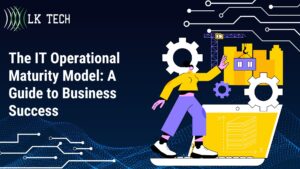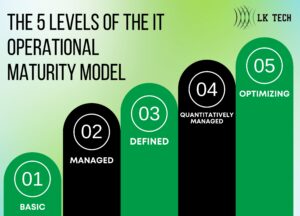An Explanatory Guide to the IT Operational Maturity Model: Achieving Business Success Through IT Excellence
Businesses today rely heavily on technology to operate efficiently and provide quality service to customers. However, integrating technology into business operations, with the support of an IT Service Provider, is an evolving process that takes time to master. This journey towards IT operational excellence is defined by the IT operational maturity model.

- The IT Operational Maturity Model A Guide to Business Success
In this post, we’ll explore:
- What the IT operational maturity model is
- Its five levels
- How reaching higher levels of maturity can boost financial performance
- Insights from LK Technologies, a leading IT services provider in Cincinnati
- Real world examples of companies at different maturity levels
- Key steps to take on the path to operational maturity
- Potential obstacles and how to overcome them
- The benefits of partnering with an experienced IT services provider
With technology rapidly evolving and competition intensifying, developing IT operational maturity is crucial for companies seeking to optimize performance, innovate and gain a competitive edge. This comprehensive guide provides an in-depth look at utilizing the maturity model framework to drive better business outcomes.
What is the IT Operational Maturity Model?
The IT operational maturity model is a framework for measuring a company's ability to effectively utilize technology to support business goals and operations. It evaluates the sophistication, efficiency and scalability of a company's IT systems and strategy relative to the company’s size and business needs.
Developed in the 1990s, maturity models originate from quality management frameworks like Total Quality Management (TQM) and Capability Maturity Model (CMM). The IT version applies this continuous improvement concept specifically to information technology management.
The model defines 5 levels of operational maturity, from basic/ad-hoc processes to highly advanced optimization of IT. As companies evolve to higher levels, they gain important capabilities like:
- Reliability of IT services
- Business/IT alignment
- Security safeguards
- Automation
- Data-driven improvements
- Innovation
Achieving these capabilities enables organizations to fully leverage technology as a strategic asset rather than just a basic business necessity.
The 5 Levels of the IT Operational Maturity Model
Let's look at the key characteristics of each level in more detail:
Level 1 - Basic
At the first level of maturity, IT management is ad-hoc and reactive. With no defined processes, the IT function is focused solely on keeping systems up and running through hands-on firefighting. This break-fix model has inherent limitations that become problematic as a company grows. Key aspects of Level 1 include:
- No policies, budgets or strategy guiding IT decisions
- Lack of monitoring and metrics
- Frequent downtime and outages
- No disaster recovery provisions
- Security an afterthought
- Little alignment between IT priorities and business objectives
This stage is common for small startups, but must evolve for long-term success.
Level 2 - Managed
At Level 2, organizations realize the shortcomings of an entirely reactive break-fix approach and take initial steps to exert more control over IT. There is recognition of the need for greater IT management, more strategic direction and basic service level monitoring. However, IT governance remains relatively unstable and inconsistent. Key aspects include:
- Implementation of basic IT policies and processes
- Budgeting for IT expenses
- Purchase of productivity software and tools
- Hiring dedicated IT staff
- Continued lack of disaster recovery plans
- Frequent workarounds needed to maintain operations
- User satisfaction remains low
Many small to medium sized companies operate at Level 1 or 2 maturity. This is often the catalyst for seeking help from managed IT services providers to improve operational efficiency, reliability and strategic direction.

- The IT Operational Maturity Model A Guide to Business Success
Level 3 - Defined
At the third level of maturity, IT processes become standardized, documented and integrated into business operations. Service quality improves through SLAs, system monitoring and better defined procedures. IT demonstrates greater reliability and starts aligning more closely with business objectives. Key aspects include:
- Documented IT policies and processes
- Established disaster recovery provisions
- Improved system uptime and availability
- Higher end-user satisfaction
- Funding based on IT strategy rather than reacting to needs
- Leveraging technology to improve business operations and growth
- Hiring staff with specialized skills like networking, security, data analytics
Reaching Level 3 requires dedicated internal IT resources and expertise or engaging an experienced IT services provider. This stage represents a tipping point where technology transitions from liability to strategic asset.
Level 4 - Quantitatively Managed
At the fourth level of maturity, management of IT becomes metrics-driven and tied to key business objectives. IT reporting provides quantitative insights to inform data-driven improvements. Technology is utilized as a core tool to drive business performance enhancements, productivity and efficiency. Key aspects include:
- Continuous monitoring, reporting and analysis of IT services
- Leveraging analytics and metrics to fine tune processes
- IT fully integrated into business operations and strategy
- Expanding automation of processes where possible
- Exploring innovative technologies like AI/ML to enable growth
- Rigorous access controls, cybersecurity safeguards
- IT recognized as differentiator and competitive advantage
Achieving Level 4 requires significant commitment, skilled resources and executive-level IT strategy. But the payoff can be substantial.
Level 5 - Optimizing
At the pinnacle of operational maturity, technology is fully ingrained into corporate strategy and culture. IT management has evolved from fixing problems to exploring blue sky opportunities. There is a relentless focus on optimization, innovation and staying ahead of the technology curve. Key aspects include:
- Seamless integration between IT and business departments
- Robust use of automation and AI to improve speed and efficiency
- Launching pilots of emerging technologies
- Mining data analytics for new revenue opportunities
- Established systems for continuous improvement
- IT budgets based on ROI and strategic impact
- CIO has prominent strategic role as driver of innovation
Attaining Level 5 is challenging but offers significant competitive advantages. Companies must remain vigilant not to become complacent and backslide.
Achieving Operational Maturity
According to LK Technologies, an IT services leader in the Cincinnati region, most mid-size companies operate at Level 1 or 2 maturity.
Progressing even to Level 3 requires dedicated internal IT resources and expertise, which many growing companies lack. Engaging an experienced external IT services provider can accelerate maturity. LK Tech's team of IT professionals can:
- Conduct assessments to determine current operational maturity levels
- Create a strategic roadmap to guide advancement to higher levels
- Provide ongoing management and maintenance of IT infrastructure
- Implement new systems, cybersecurity controls, and IT processes
- Apply IT industry best practices tailored for the organization
- Offer strategic guidance aligned to business growth objectives
This partnership approach enables organizations to improve IT performance, achieve operational goals, and get the most value from technology investments.
Some key steps companies can take with LK Tech to mature IT operations:
- Document IT policies, processes and disaster recovery plans
- Implement monitoring and management tools
- Develop IT metrics and reporting
- Identify opportunities for automation
- Conduct a technology audit for upgrades
- Strengthen cybersecurity protections
- Build 3-5 year IT strategic plan
Overcoming Common Maturity Obstacles
Advancing IT operational maturity model often encounters roadblocks that stall progress if not addressed:
Budget Constraints
Upgrading technology and processes requires investment. Building a strong business case for IT maturity demonstrates how technology, when properly leveraged, drives productivity, efficiency and growth to deliver compelling ROI.
Lack of IT Resources
Reaching advanced stages of operational maturity requires skilled IT staff. Partnering with a managed IT services provider adds this expertise.
No Strategic IT Roadmap
A detailed, documented plan provides a blueprint for advancing through maturity levels instead of ad-hoc reactive fixes.
Security as Afterthought
Cyberthreats make security imperative at every stage. Prioritizing safeguards, access controls and preparedness ensures protection.
Siloed IT-Business Alignment
Close collaboration between IT and business leaders is essential for maturity. Ensuring IT projects support business objectives is key.
Complacency
Even companies reaching advanced maturity can slide backwards by resting on their laurels. Regular self-assessments help sustain momentum.
The Path to Improved Performance
Research shows that higher levels of operational maturity strongly correlate with better financial performance. According to a study published in MIS Quarterly Executive, companies at the top two levels of maturity enjoy up to three times greater profitability compared to the median:
| Maturity Level | Profitability |
|---|---|
| Level 4-5 | Up to 3x more profitability |
| Median | Baseline profitability |
This data quantitatively demonstrates how developing IT operational maturity model and strategy contributes directly to the bottom line. Technology transitions from a cost center to a profit driver.
Here are some examples of how technology innovation and operational excellence unlocked by maturity can boost financial performance:
- Enhanced productivity and efficiency - Systems automation, improved uptime, and optimized processes reduce costs and resources needed to operate. Staff can focus on more strategic work.
- Strengthened security - Reduced downtime and data breach costs through cybersecurity defenses and preparedness. Avoiding outages prevents losses.
- Better customer experiences - Smooth IT operations and digital capabilities enable superior customer service. This builds loyalty and new business.
- New revenue streams - Data analytics and emerging tech pilots uncover new products, services and markets. First mover advantage is gained.
- Improved decision making - Data-driven analytics and reporting provide real-time business insights for smarter planning.
- Competitive differentiation - Leading-edge IT delivers advantages competitors lack, enabling gains in market share.
These improvements demonstrate how technology transitions from a basic operational necessity to a true difference-making asset when managed to its full strategic potential.
Conclusion
The IT operational maturity model provides a powerful framework for organizations to optimize technology management and strategically align it with business goals. While progress takes time and continuous effort, partnering with experienced IT services experts like LK Technologies can accelerate your maturity journey. LK Tech offers the guidance, resources and solutions to help Cincinnati companies achieve IT excellence – enabling them to reduce costs, strengthen security, innovate, and ultimately drive better financial performance.
Contact LK Technologies today to schedule your initial maturity assessment. An LK Tech IT advisor based in Cincinnati, Ohio will review your current IT operations, risks and needs. They will then create a customized roadmap to guide your advancement through the maturity model. With technology advancing at breakneck speed, developing IT operational maturity model is key to competing and thriving in today’s digital business landscape. Partner with LK Tech to embark on your maturity journey and realize the many rewards of IT excellence.


